
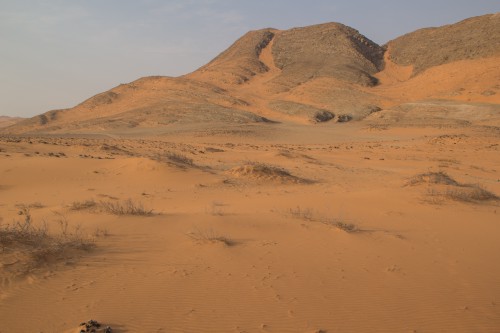
We woke up to the soothing sounds of the African Mourning Doves (Streptopelia decipiens), which have an almost purring sound. Justin decided he wanted to find some audio of their song for a new ringtone, and the best he has found (for what they sound like, not a ringtone) is here (also in the little player below). At breakfast, the only folks around were Richard/Vivian and Tricia. On our way out of camp, along the boardwalk we saw some weavers - not the same kind as in Kulala, though.
 |
 |
Our morning excursion was to go see the local Himba people. The Himba are semi-nomadic people, an offshot of the Herero. They breed cattle and goats, and travel where they need to in order for the cattle and goats to have sufficient food. They live mostly in northern Namibia, but some live north of the Kunene river in Angola as well. Since Namibian independence, they've been able to maintain their culture and their way of life, as the area they live is hardly populated and outside interference has been a minimum. There are a couple villages near Serra Cafema, and the one we happened to visit this morning had three generations, one male, his wife, and several daughters, some of them with kids. The cows were not around, as they were out feeding in the area. The small village had a handful of chickens and one dog, with the dog being used to help herd the cattle when necessary. It was very interesting, but it always feels weird going to places with indigenous people, as it feels like we are intruding, changing their lifestyle.
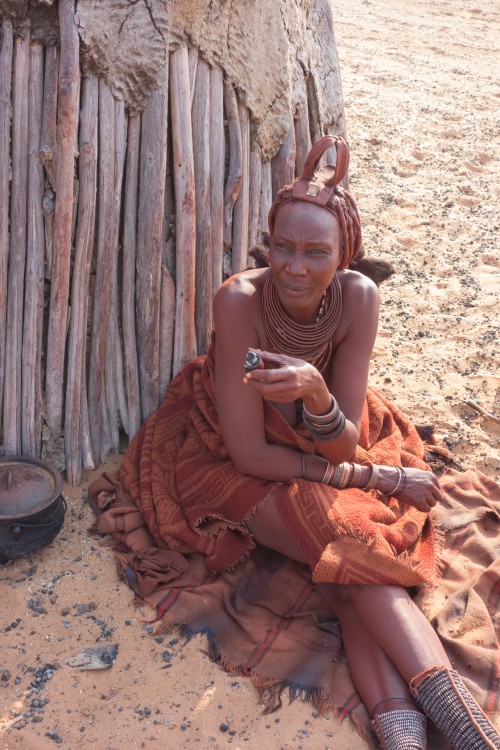 |
|
 |
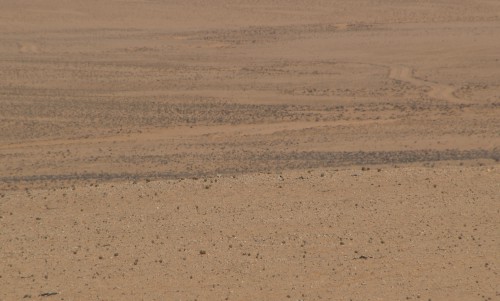 |
After leaving the village, we went searching for Meerkats. They live in the area, but as a general matter don't come anywhere close to the trucks, so it's not like checking out meerkats at the zoo. Also, they are the same color as the ground, so even though the grass was basically non-existent, they would still be hard to see. We did find some, but very far away. If they hadn't been moving, we doubt we would have seen them. While driving along we stumbled across some bat-eared foxes, who were sleeping in a little ditch very close to the road. We also saw many more Oryx. It is truly incredible how they can not only survive, but thrive, in these conditions. Gerhardus told us that it hadn't rained in nearly two years, but that when it does rain, the entire Hartmann Valley turns bright green and looks like a golf course. Maybe one of these days we'll be lucky enough to come back when it looks like that. We went to a nice lookout point over the valley, and while there spotted an interesting lizard walking around the rocks.
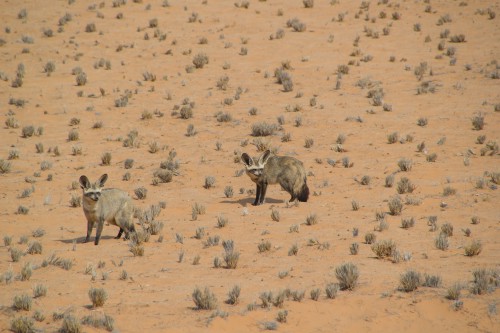 |
 |
 |
 |
From the vantage point, we drove back to camp, and got back right at noon. The Camp Manager Elaine told us that we'd have a special lunch at 12:30, by ourselves, on the west end of camp overlooking the river. By this time we were the only guests at camp, as everyone else had left that morning. The lunch was very good, but it was very windy, and near the end of the meal a gust of wind knocked stuff over, including water and wine. In the afternoon, we went on a boat cruise. The water level was very low, so we didn't go very far. Right along the river bank we saw lots of Golden Weavers and their nests, not too far upriver from our room. We also saw some Himba-related folks on the Angolan side of the river. In the middle of the river there was a cormorant drying out its wings. Gerhardus was looking for crocodiles, and for awhile we couldn't find anything, but eventually found a fairly small one near the Angolan river bank. We then saw a much larger one up the river, but we couldn't get there because of low water level.
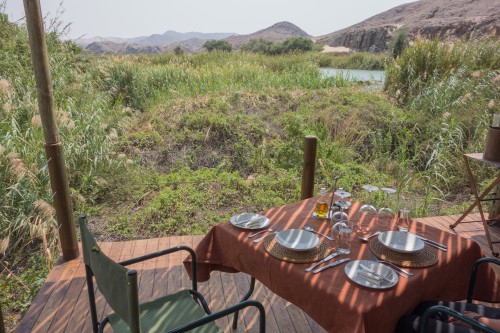 |
 |
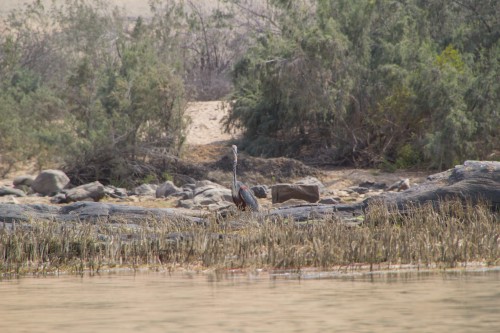 |
 |
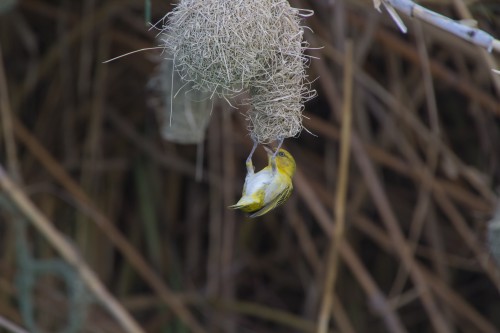 |
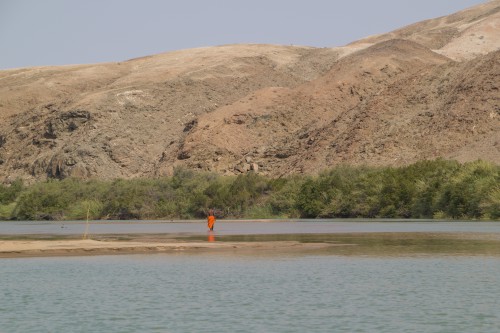 |
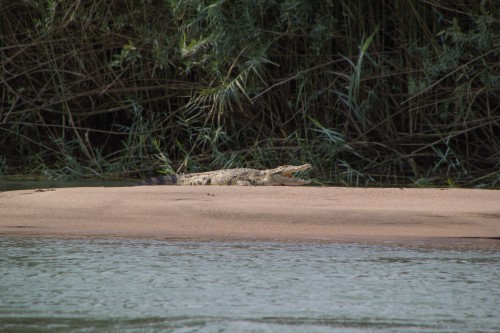 |
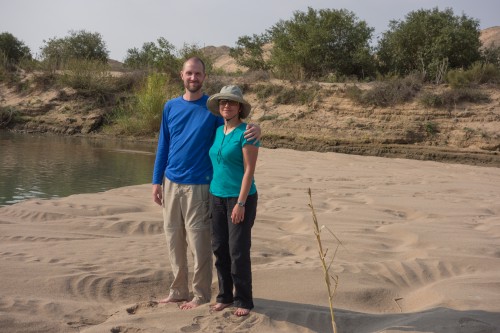 |
On the way back, we stopped for a short walk on the Angolan side of the river, making Angola the 10th African country we've visited. Just before getting back to the camp, we saw a baby crocodile in a spot Gerhardus told us he often sees a big crocodile - perhaps the big one had babies. Back at camp, we had some sundowners, and as we were heading back to our room Elaine told us that we needed to wear shoes for dinner. She said we'd be going "scorpion hunting" before having dinner, so the shoes were necessary.
 |
 |
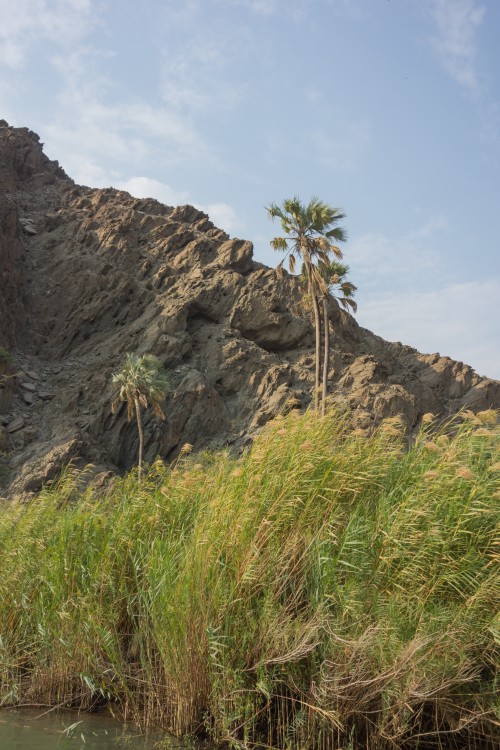 |
 |
We didn't actually go scorpion hunting, though, we just took a 2 minute drive to an area just west of camp where they had set up a candlelight dinner for us and the other guests (who had just arrived) in this protected sandy area near the rapids. We guessed we couldn't have been more than 100-200 meters from where we had lunch. But unlike lunch, it was way less windy. The food was great, particularly the Kudu main course. We also had a cabernet from Vergelegen, which happened to be one of the wineries we visited near Cape Town in 2007. After dinner we came back and chatted for an hour or two with Elaine about Vergelegen (we showed her some pictures of the grounds), Madagascar, Seychelles (where she had worked for several months), and more. Of all the camp managers we've come across, she seemed to be the best, really going above and beyond to make sure that people have not only a great stay but also some memorable experiences.